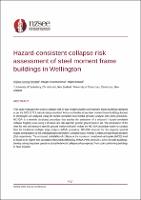| dc.contributor.author | Gurung Shrestha, Srijana | |
| dc.contributor.author | Chandramohan, Reagan | |
| dc.contributor.author | Dhakal, Rajesh | |
| dc.date.accessioned | 2021-06-22T04:02:06Z | |
| dc.date.available | 2021-06-22T04:02:06Z | |
| dc.date.issued | 2021-04-14 | |
| dc.identifier.uri | https://repo.nzsee.org.nz/xmlui/handle/nzsee/2425 | |
| dc.description.abstract | This study evaluates the seismic collapse risk of two modern ductile steel moment frame buildings designed as per the NZS 1170.5 seismic design standard. A four and twelve storey steel moment frame buildings located in Wellington are analysed using the hazard-consistent incremental dynamic analysis (HC-IDA) procedure. HC-IDA is a recently developed procedure that enables the estimation of a structure’s hazard-consistent collapse fragility curve using a structure and site-agnostic generic ground motion set. The elimination of the need for site and structure-specific ground motion selection makes the HC-IDA procedure easier to conduct than the traditional multiple stripe analysis (MSA) procedure. HC-IDA accounts for the response spectral shapes and durations of the anticipated ground motions using the scalar metrics SaRatio and significant duration (Ds) respectively. The computed probability of collapse at the maximum considered earthquake (MCE) level is found to be higher than acceptable thresholds defined by FEMA P695 and NZS 1170.5 for both buildings, thereby raising important questions about the level of collapse safety expected from code-conforming buildings in New Zealand. | |
| dc.language.iso | en | |
| dc.publisher | New Zealand Society for Earthquake Engineering | |
| dc.relation.ispartofseries | 2021;0072 | |
| dc.subject | Engineering assessments for general purposes and potentially earthquake-prone buildings | |
| dc.title | Hazard-consistent collapse risk assessment of steel moment frame buildings in Wellington | |
| dc.type | Article | |

